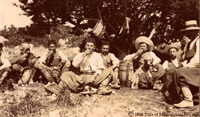
The mountain citadel of Vrokastro overlooks the west-central coast of the broad Gulf of Mirabello in eastern Crete. Vrokastro is an important site in the archaeological record as a defensive or refugee settlement that bridges the end of the Bronze Age and the beginning of the early Iron Age. The site was first inhabited during the Middle Minoan period (ca. 2100 to 1700), then reoccupied at the end of the Bronze Age (ca. 1250 B.C.), and continuously inhabited until the seventh century B.C. In 1910 and 1912, this settlement was excavated for the University Museum by Edith Hall, who uncovered a Middle Minoan and Early Iron Age settlement on the peak and north slope of the 300 m. high mountain. She also excavated cemeteries spanning a period from LM IIIC (ca. 1200 B.C.) through late Geometric (700/650 B.C.).
Although Hall's investigation of the Vrokastro region was a pioneering effort, data derived from her initial investigations of the site were incomplete. Only systematic and intensive survey can provide the necessary framework for analysis, and a new Vrokastro Survey Project was consequently initiated by Dr. Barbara J. Hayden (Senior Research Scientist, Mediterranean Section, University Museum).
The Vrokastro survey is based on a four-part approach involving:
1. an archaeological program (intensive exploration of the landscape supported by pottery analyses)
2. a scientific program (study of the regional botany, soil, geology)
3. an historical program (comprising analysis of ancient sources, regional demographics Venetian and Ottoman archives, and the development of the regional monasteries); and
4. an ethnographic program (comprising the documentation of agricultural practices and crops cultivated, demographics, pastoralism, and the carrying capacity of the land).
The goals of this multidisciplinary project are to place Vrokastro and other regional sites in an historical and environmental context, and to compare the results of this study to data collected from other regional surveys in Crete and the Aegean.
